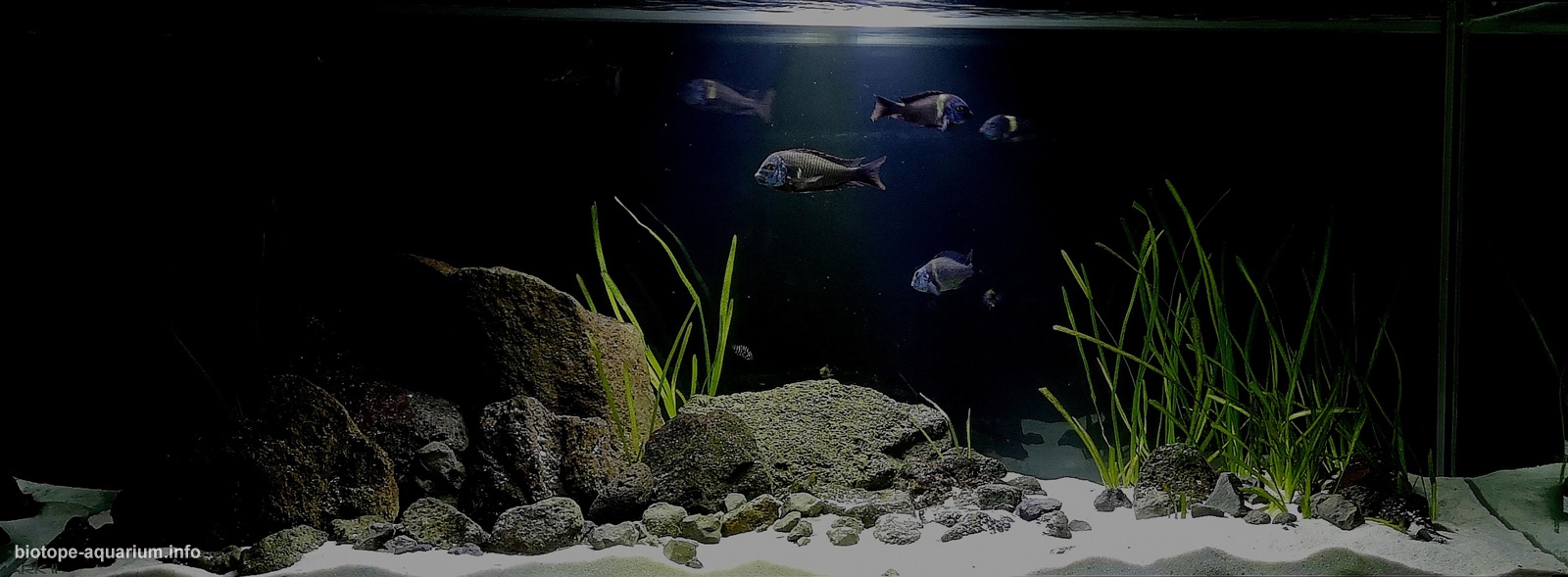Lake Tanganyika, at Pemba, Democratic Republic of the Congo
91st place in Biotope Aquarium Design Contest 2018
![]() Iceland. Migle Milinauskaite
Iceland. Migle Milinauskaite

Volume: 325 L
Dimensions: 130x50x50 cm
List of fishes: Tropheus duboisi, Tropheus sp. Pemba, Synodontis petricola
List of plants: Vallisneria spiralis
Description of decorations: A sand used to be as close as possible of in natural habitat of Lake Tanganyika, cichlid sand white 0.3-0.8 mm. The stones came from lake of Urridavatn in Iceland.
Description of equipment: Fluval FX6 External Aquarium Filter, pump output: 3500 lph with only 41 W power consumption for aquariums up to 1500 litres content. Aquarium lighting: original Akvastabil lights T5 blue and white and extra led light.
Water parameters: Temperature is 25.5°C, pH is 8.7, GH is 13, KH is 14.
INFORMATION ABOUT BIOTOPE
Description of the area surrounding the biotope: Lake Tanganyika is a large with a length of about 650 km and average width of about 50 km, and lies in a roughly, north-south position in the western arm of Africa’s Great Rift Valley. Its coastline traverses four different countries, with the Democratic Republic of the Congo and Tanzania possessing the largest parts. The northeastern section belongs to Burundi and the southernmost shores lie in Zambian territory. Lake Tanganyika is the second deepest lake in the world (1470 meters). The precipitation during the rainy season (from October to December and from the end of February to April in the north, and from November to March in the south) raises the water level visibly and carries a lot of sediment into the lake. Particularly in the northern end of the lake, the long rainy period causes frequent plankton blooms and hence low visibility in the normally crystal clear waters of the lake, which normally ranks as one of the clearest fresh waters in the world: visibility can be more than 20 meters. In sandy and muddy areas visibility is, of course, much reduced due to the suspend particles of sediment. Only on windless days is visibility here likely to exceed 10 meters. Although the lake is very deep, oxygen is present only in the upper water layer.
Description of the underwater landscape of the biotope: During the last ice age, there was a time when the lake was filled with stones. The river is full of useful minerals, so there are so many fish in the lake. There is not much vegetation in the lake. Mostly found in river streams or in places of the lake, where the depth does not reach 5 meters.
Description of the parameters of the habitat: The temperature of the surface waters of the lake varies between 25.5°C in the coolest months (August) and 27.7°C in the warmest month (February), the pH is from 8.8 to 9.2, and the conductivity is from 590 to 700 μS/cm.
List of fishes and invertebrates occurring in the nature biotope: Tropheus sp. Pemba, Tropheus duboisi, Tropheus sp. Moliro, Limnocnida tanganicae, Plathelphusa armata, Eretmodus marksmithi, Pseudosimochromis curvifrons, Petrochromis macrognathus, Ophthalmotilapia heterodonta, Neolamprologus pulcher, Altolamprologus compressiceps, Telmatochromis temporalis, Calidochromis popelini, Julidochromis marlieri, Paracprichromis nigripinnis, Callochromis melanostigma.
List of plants found in the nature biotope: Most often found plants in Tanganyika lake are: Vallisneria spiralis, Cerathophylum demersum, Myriophylum spicatum, Hydrylla verticillata, Cyperus alternifolius, Cyperus papirus, Nymphaea lotus form, Pistia stratiotes, Riccia fluitans.
Threats to the ecology: In a country where I live there is not a big choice, especially in the African cichlids. My goal is to keep these species in the country, to breed them, so that the species would never be on the verge of extinction. In my example, I want to show people how important it is to have the same lake fish, especially when the same diet.
Sources of information:
Book: Tanganyika Cichlids it their natural habitat, 3rd edition, Ad Konings, google.
